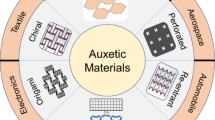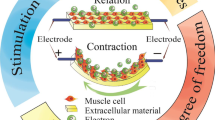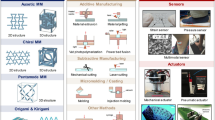Abstract
The present article aims to investigate the mechanical properties of a new DNA origami nano-joint using the steered molecular dynamics (SMD) simulation. Since the analysis of mechanical properties is of great importance in bending conditions for a nano-joint, the forces are selected to achieve angular changes in the joint by the resultant torque. In this study, the nano-joint is considered as a beam in order to use mechanical equations to extract the mechanical properties of the designed nano-joint. In addition, the bending stiffness of the beam is investigated in different modes of deflection using the Euler–Bernoulli beam theory. The results revealed that the value of bending stiffness increases with increasing deflection, and the changes in the bending stiffness relative to the deflection is linear. The proposed DNA origami nano-joint can be used as a joint in nanorobots and can be effectively applied in nanorobotic systems to move different components.












Similar content being viewed by others
References
Cocco, S., Markob, J. F., & Monasson, R. (2002). Theoretical models for single-molecule DNA and RNA experiments: From elasticity to unzipping. Comptes Rendus Physique, 3, 569–584.
Seeman, N. C. (2010). Nanomaterials based on DNA. Annual Review of Biochemistry, 79, 65–87.
Han, D., Pal, S., Nangreave, J., Deng, Z., Liu, Y., & Yan, H. (2011). DNA origami with complex curvatures in three-dimensional space. Science, 332, 342–346.
Rothemund, P. W. K. (2006). Folding DNA to create nanoscale shapes and patterns. Nature, 440, 297–302.
Castro, C. E., Kilchherr, F., Kim, D.-N., Shiao, E. L., Wauer, T., Wortmann, P., Bathe, M., & Dietz, H. (2011). A primer to scaffolded DNA origami. Nature Methods, 8, 221–229.
Linko, V., & Dietz, H. (2013). The enabled state of DNA nanotechnology. Current Opinion in Biotechnology, 24, 555–561.
Langecker, M., Arnaut, V., Martin, T. G., List, J., Renner, S., Mayer, M., Dietz, H., & Simmel, F. C. (2012). Synthetic lipid membrane channels formed by designed DNA nanostructures. Science, 338, 932–936.
Khosravi, R., Ghasemi, R. H., & Soheilifard, R. (2020). Design and simulation of a DNA origami nanopore for large cargoes. Molecular Biotechnology, 62(9), 423–432.
Douglas, S. M., Bachelet, I., & Church, G. M. (2012). A logic-gated nanorobot for targeted transport of molecular payloads. Science, 335, 831–834.
Zadegan, R. M., Jepsen, M. D. E., Thomsen, K. E., Okholm, A. H., Schaffert, D. H., Andersen, E. S., Birkedal, V., & Kjems, J. (2012). Construction of a 4 zeptoliters switchable 3D DNA box origami. ACS Nano, 6, 10050–10053.
Mogheiseh, M., Ghasemi, R. H., & Soheilifard, R. (2020). The effect of crossovers on the stability of DNA origami type nanocarriers. Multidiscipline Modeling in Materials and Structures, in press.
Zhou, L., Marras, A. E., Su, H.-J., & Castro, C. E. (2014). DNA origami compliant nanostructures with tunable mechanical properties. ACS Nano, 8(1), 27–34.
Tinland, B., Pluen, A., Sturm, J., & Weill, G. (1997). Persistence length of single-stranded DNA. Macromolecules, 30, 5763–5765.
Wolfe, K. C., Hastings, W. A., Dutta, S., Long, A., Shapiro, B. A., Woolf, T. B., Guthold, M., & Chirikjian, G. S. (2012). Multiscale modeling of double-helical DNA and RNA: A unification through lie groups. The Journal of Physical Chemistry B, 116, 8556–8572.
Marko, J. F., & Siggia, E. D. (1995). Stretching DNA. Macromolecules, 28, 8759–8770.
Cohen, A. E., & Moerner, W. E. (2007). Principal-components analysis of shape fluctuations of single DNA molecules. Proceedings of the National academy of Sciences of the United States of America, 104, 12622–12627.
Culpepper, M. L., DiBiasio, C. M., Panas, R. M., Magleby, S., & Howell, L. L. (2006). Simulation of a carbon nanotube-based compliant parallel-guiding mechanism: A nanomechanical building block. Applied Physics Letters, 89(20), 203111/1-203111/3.
Magleby, S. P., Culpepper, M. L., Howell, L. L., Panas, R., & DiBiasio, C. M. (2008). Comparison of molecular simulation and pseudo-rigid-body model predictions for a carbon nanotube-based compliant parallel-guiding mechanism. Journal of Mechanical Design, 130, 042308/1-042308/7.
Howell, L. L., & Midha, A. (1994). A method for the design of compliant mechanisms with small-length flexural pivots. Journal of Mechanical Design, 116, 280–290.
Howell, L. L. (2001). Compliant mechanisms (pp. 10–18). New York: Wiley-Interscience.
Marras, A. E., Zhou, L., Su, H.-J., & Castro, C. E. (2015). Programmable motion of DNA origami mechanisms. Proceedings of the National Academy of Sciences USA. https://doi.org/10.1073/pnas.1408869112
Castro, C. E., Su, H.-J., Marras, A. E., Zhou, L., & Johnson, J. (2015). Mechanical design of DNA nanostructures. Nanoscale, 7(14), 5913–5921.
Zhou, L. (2017). Design modeling and analysis of compliant and rigid-body DNA origami mechanisms’, PhD Thesis, The Ohio State University
Dastorani, S., Mogheiseh, M., Ghasemi, R. H., & Soheilifard, R. (2020). Modeling and Structural investigation of a new DNA origami based flexible bio-nano joint. Molecular Simulation. https://doi.org/10.1080/08927022.2020.1797019
Ghasemi, R. H., Keramati, M., & Mojarrad, M. H. S. (2019). The effect of structure on improvement of the PNA Young modulus: A study of steered molecular dynamics. Computational Biology and Chemistry, 83, 107–133.
Peters, J. P., Yelgaonkar, S. P., Srivatsan, S. G., Tor, Y., & James Maher, L., III. (2013). Mechanical properties of DNA-like polymers. Nucleic Acids Research, 41, 10593–10604.
Kim, Y. J., & Kim, D. N. (2016). Structural basis for elastic mechanical properties of the DNA double helix. PloS One, 11, e0153228.
Kim, Y.-J., & Kim, D.-N. (2016). Sensitivity analysis for the mechanical properties of DNA bundles. Journal of Nanomaterials. https://doi.org/10.1155/2016/6287937
Sevier, S. A. (2020). Mechanical properties of DNA replication. Physical Review Research, 2, 023280.
Shrestha, P., Emura, T., Koirala, D., Cui, Y., Hidaka, K., Maximuck, W. J., Endo, M., Sugiyama, H., & Mao, H. (2016). Mechanical properties of DNA origami nanoassemblies are determined by holliday junction mechanophores. Nucleic Acids Research, 44, 6574–6582.
Suma, A., Stopar, A., Nicholson, A. W., Castronovo, M., & Carnevale, V. (2020). Global and local mechanical properties control endonuclease reactivity of a DNA origami nanostructure. Nucleic Acids Research, 48, 4672.
Helfrich, W. (1973). Elastic properties of lipid bilayers: Theory and possible experiments. Zeitschrift für Naturforschung C, 28(11), 693–703. https://doi.org/10.1515/znc-1973-11-1209
Douglas, S. M., Marblestonen, A. H., Teerapittayanon, S., Vazquez, A., Church, G. M., & Shih, W. M. (2009). Rapid prototyping of 3D DNA-origami shapes with caDNAno. Nucleic Acids Research, 37(15), 5001–5006.
Yoo, J., & Aksimentiev, A. (2013). In situ structure and dynamics of DNA origami determined through molecular dynamics simulations. Proceedings of the National Academy of Sciences USA, 110, 20099–20104.
Author information
Authors and Affiliations
Corresponding author
Ethics declarations
Conflict of interest
The authors declare that they have no conflict of interest.
Additional information
Publisher's Note
Springer Nature remains neutral with regard to jurisdictional claims in published maps and institutional affiliations.
Rights and permissions
About this article
Cite this article
Dastorani, S., Ghasemi, R.H. & Soheilifard, R. A Study on the Bending Stiffness of a New DNA Origami Nano-Joint. Mol Biotechnol 63, 1057–1067 (2021). https://doi.org/10.1007/s12033-021-00367-y
Received:
Accepted:
Published:
Issue Date:
DOI: https://doi.org/10.1007/s12033-021-00367-y




